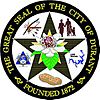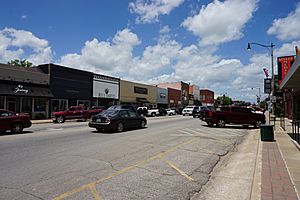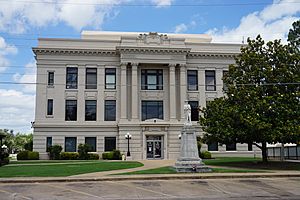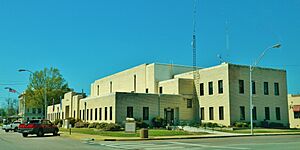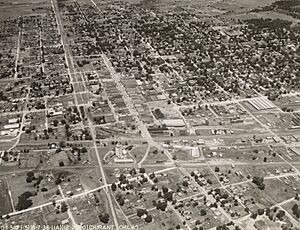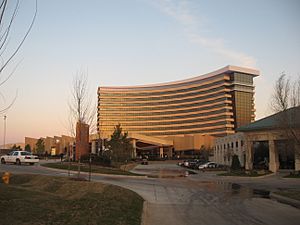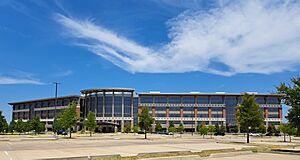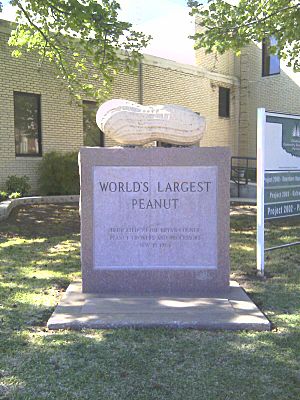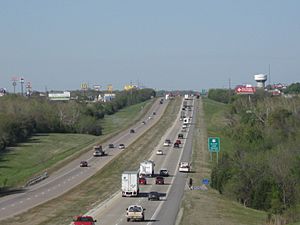Durant, Oklahoma facts for kids
Quick facts for kids
Durant, Oklahoma
|
||
|---|---|---|
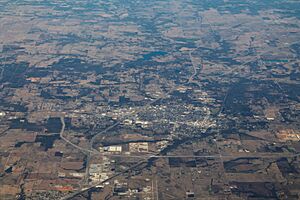
Aerial view of Durant
|
||
|
||
| Nickname(s):
City of Magnolias and Gateway to Lake Texoma
|
||
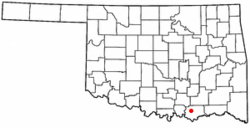
Location within the state of Oklahoma
|
||
| Country | United States | |
| State | Oklahoma | |
| County | Bryan | |
| Area | ||
| • Total | 27.83 sq mi (72.08 km2) | |
| • Land | 27.76 sq mi (71.89 km2) | |
| • Water | 0.07 sq mi (0.18 km2) | |
| Elevation | 669 ft (204 m) | |
| Population
(2020)
|
||
| • Total | 18,589 | |
| • Density | 669.68/sq mi (258.56/km2) | |
| Time zone | UTC-6 (CST) | |
| • Summer (DST) | UTC-5 (CDT) | |
| ZIP codes |
74701-74702
|
|
| Area code(s) | 580 | |
| FIPS code | 40-22050 | |
| GNIS feature ID | 2410375 | |
Durant is a city in Bryan County, Oklahoma, United States. In 2020, about 18,589 people lived there. It is the main city and capital of the Choctaw Nation, an important Native American tribe. Durant is also the largest town in the Choctaw Nation's territory.
The city was started by Dixon Durant, a Choctaw man, in the early 1870s. This happened after the MK&T railroad built tracks through the area, which was then called the Indian Territory. When Oklahoma became a state in 1907, Durant became the main city for Bryan County.
Durant is home to Southeastern Oklahoma State University and the main offices of the Choctaw Nation. The city is known as the "Magnolia Capital of Oklahoma" because of its many beautiful magnolia trees. It is also a big part of the Texoma region, which is near Lake Texoma.
Contents
History of Durant
The land where Durant now stands was once claimed by both Spain and France. It became part of the United States after the Louisiana Purchase and the Adams–Onís Treaty. In the 1820s and 1830s, this area was set aside for the Choctaw Nation. The Choctaw people moved here from their original homes in Mississippi and Alabama during a journey known as the Choctaw Trail of Tears.
In 1832, Pierre Durant and his four sons, who were of French and Choctaw heritage, arrived in this part of the Choctaw Nation. One of his sons, Fisher Durant, found a good spot for a home. Fisher's son, Dixon Durant, is known as the founder of Durant. He was a minister, businessman, and community leader.
Dixon Durant opened the first general store in 1873. This was around the time the Missouri–Kansas–Texas Railroad (also called the Katy Railroad) built a train stop here in 1872. A train car was used as "Durant Station." The first post office opened in 1879, and by 1882, the area was simply called Durant. W.H. Hilton was elected the first mayor.
An exciting event happened on April 5, 1905, when President Theodore Roosevelt stopped in Durant on a special train and gave a speech. In 1895, a fire destroyed the first business area of the city.
In 1894, a school called Calvin Institute opened in Durant for Native American youth. It later became Durant Presbyterian College and then Oklahoma Presbyterian College. In 1909, a state school called Southeastern State Normal School opened. This school eventually became Southeastern Oklahoma State University.
Durant was chosen as the main city for Bryan County in 1908. Bryan County was created from Choctaw lands in 1907 and was named after William Jennings Bryan, a famous politician. In April 1919, a tornado hit Durant, sadly killing eleven people. The city's population grew from 2,969 people in 1900 to 18,589 in 2020. The historic downtown area of Durant is listed on the National Register of Historic Places.
Geography and Climate
Durant is in southeastern Oklahoma, close to the Texas border and Lake Texoma. This area is often called Texoma or Texomaland. It is also part of Choctaw Country. The city is about 14 miles (23 km) north of the Red River, which forms the border with Texas. Dallas, Texas, is about 88 miles (142 km) south of Durant.
The city of Durant covers about 27.83 square miles (72.08 km2). Most of this area is land, with a small amount of water.
Weather in Durant
Durant has a climate with hot summers and mild winters. The hottest month is August, with average high temperatures around 96°F (36°C). The coldest month is January, with average low temperatures around 31°F (-0.6°C). Durant gets about 39.5 inches (100 cm) of rain each year. Snowfall is very light, averaging about 2.7 inches (6.9 cm) per year.
Population and People
| Historical population | |||
|---|---|---|---|
| Census | Pop. | %± | |
| 1900 | 2,969 | — | |
| 1910 | 5,330 | 79.5% | |
| 1920 | 7,340 | 37.7% | |
| 1930 | 7,463 | 1.7% | |
| 1940 | 10,027 | 34.4% | |
| 1950 | 10,541 | 5.1% | |
| 1960 | 10,467 | −0.7% | |
| 1970 | 11,118 | 6.2% | |
| 1980 | 11,972 | 7.7% | |
| 1990 | 12,823 | 7.1% | |
| 2000 | 13,549 | 5.7% | |
| 2010 | 15,856 | 17.0% | |
| 2020 | 18,589 | 17.2% | |
| Sources: | |||
In 2020, Durant had a population of 18,589 people. The city is home to a diverse group of people. About 60.5% of residents were White, 13.7% were Native American, and 10.3% were Hispanic or Latino. About 11.9% of people identified as having two or more races.
In 2010, there were 15,856 people living in Durant. About 22% of the population was under 18 years old. The average age was about 30.9 years. There were slightly more females than males. The median income for a household in the city was about $35,135 per year.
Economy and Jobs
Durant has been recognized as one of the fastest-growing rural cities in Oklahoma. This means it's growing quickly outside of the very large cities like Oklahoma City and Tulsa.
Many people come to Durant for work or to visit. The city's economy has seen a lot of new investments, totaling over $600 million since 1999.
Tourism is a strong industry in Durant. People visit Lake Texoma, the Choctaw Casino Resort, and Fort Washita. Manufacturing and distribution businesses are also growing, with new factories being built.
The biggest employer in Durant is the Choctaw Nation of Oklahoma. They run the Choctaw Nation Headquarters and the Choctaw Casino Resort. Over 5,400 people work for the Choctaw Nation in Durant. Even though the official capital of the Choctaw Nation is Tuskahoma, many of their main offices are in Durant.
The Choctaw Nation's administrative offices are located in the old Oklahoma Presbyterian College Building. This building was once a school for Native American youth, established in 1894. The Choctaw Nation took over the building in 1975, and it has been renovated to house many of their programs.
Durant's downtown area and retail district are also important for the economy. The downtown has seen improvements and new businesses. The retail district, located west of downtown, is growing quickly. Large companies like Cardinal Glass Industries and Big Lots have facilities in Durant, providing many jobs. Durant is also home to the headquarters of First United Bank, one of the largest privately owned banks in the U.S.
Arts and Culture
Durant hosts the annual Magnolia Festival, which celebrates the city's nickname as the "Magnolia Capital of the World." This festival happens after Memorial Day weekend and includes music, shopping, shows, and pageants.
You can also find the Three Valley Museum in Durant. This museum shows historical items from Bryan County. It's named after a book about Durant, which called the city the "Queen of the Three Valleys" because it's located near the Red, Blue River, and Washita River valleys. The museum has exhibits that look like old offices, a child's room, and a general store.
Durant is also home to the Oklahoma Shakespearean Festival, held at Southeastern Oklahoma State University. This festival is a popular summer theater event that brings actors and theater lovers to the city.
Sports and Recreation
Durant offers many sports opportunities, even though it doesn't have major professional sports teams. The city has the Durant Multi-Sports Complex, golf courses, soccer fields, and baseball fields.
The Durant Multi-Sports Complex is a large athletic area with baseball and softball fields, soccer pitches, and a football stadium with a track. It covers 80 acres (32 ha) and cost $7 million to build. A lake and walking trails are also planned for the complex.
College Sports
Southeastern Oklahoma State University has college sports teams called the Savage Storm. They compete in NCAA Division II in the Great American Conference. Their sports include baseball, basketball, football, tennis, golf, rodeo, cross country, softball, track & field, and volleyball. In 2000, the baseball team won the Division II college world series!
Parks and Outdoor Fun
The City of Durant has 11 parks that cover more than 251 acres (102 ha). Some of these parks include:
- Durant Multi-Sports Complex
- Dixon Durant Park (named after the city's founder)
- Carl Albert Memorial Park & public pool
- Lake Durant
Just under 15 miles (24 km) away is Lake Texoma. This huge lake gets between 8 to 10 million visitors every year. It is the 12th largest lake in the United States and one of the country's largest reservoirs. Lake Texoma is a big reason for Durant's growth and tourism.
Education
Higher Education
Durant is home to Southeastern Oklahoma State University, which has about 5,200 students. It's special because it's the only university in Oklahoma that offers a Master of Science degree in Aviation and Space. The university has a large aviation program with facilities at the airport for flight training and on campus for managing aviation businesses, safety, and security.
Technical Training
The Kiamichi Technology Center is also in Durant. It offers career and technical training and has other locations in southeastern Oklahoma.
Schools for Kids
The Durant Independent School District is the largest school district in southeastern Oklahoma, serving about 3,100 students. It includes six schools, from preschool to high school. There are also other school districts nearby, like Silo School District and Rock Creek School District. Durant also has a private school called Victory Life Academy for students from kindergarten through 12th grade.
Media and News
Durant has a local newspaper called The Durant Democrat, which is published three times a week. While there are no TV studios in the city, residents can watch TV channels from nearby cities like Sherman and Denison, Texas. The city also has a local cable TV and Internet provider called Vyve.
In 2016, Durant gained some attention when an online petition was created to change the city's name to "Westbrook." This was a joke by an Oklahoma City Thunder fan after basketball player Kevin Durant left the team. Even though the city wasn't named after the basketball player, the story was covered by ESPN and The New York Times.
In December 2016, the Durant Fire Department's annual Christmas card became famous. They featured six babies born to firefighters that year, showing the strong family bond within the department.
Transportation
Durant is a hub for roads and railroads. Major highways like US 69/US 75 (a north-south highway) and US 70 (an east-west highway) pass through the city. These highways connect Durant to other important cities like Dallas.
The city has four exits from U.S. 69/75, making it easy to get around. Intercity bus service is available through Greyhound Lines.
Airports
Durant Regional Airport – Eaker Field is the city's airport. It's also home to Southeastern Oklahoma State University's Aviation Sciences Institute. The airport is named after General Ira C. Eaker, a famous U.S. Army Air Force general who graduated from the university. The closest large international airports are Dallas/Fort Worth International Airport and Will Rogers World Airport in Oklahoma City.
Railroads
Durant is an important railroad center. The large Union Pacific Railroad and the smaller Kiamichi Railroad tracks cross paths in downtown Durant.
Healthcare
Durant has a hospital called AllianceHealth Durant, which was built in 1987. Emergency medical services are provided by Bryan County EMS.
Famous People from Durant
Many notable people have connections to Durant, including:
- Henry G. Bennett, a long-serving president of Oklahoma State University.
- Brett Butler, a professional baseball player.
- Joe Dobson, a Major League Baseball pitcher.
- Gail Farrell, a cast member from The Lawrence Welk Show.
- Billie Letts, a well-known author.
- Tracy Letts, a famous playwright and actor.
- Reba McEntire, a Grammy Award-winning singer and actress.
- Dennis Rodman, a professional basketball player.
- Uldine Utley, a child preacher who spoke to large crowds.
- Robert L. Williams, the first Chief Justice of the Oklahoma Supreme Court and a former Governor of Oklahoma.
Special Moments in Durant's History
Durant has been part of some interesting national events and visits:
- On April 5, 1905, President Theodore Roosevelt visited Durant and gave a speech from his train. He came back in 1910 for a hunting trip.
- First Lady Eleanor Roosevelt visited Durant on March 20, 1937. She spoke to a large group of students at Southeastern Teachers College and met many people.
- In 1953, actor José Ferrer and actress/singer Rosemary Clooney were married in Durant.
- On July 15, 2015, President Barack Obama visited Durant High School. He spoke about his "Promised Zone" program, which helps create jobs and improve the economy in certain areas, including the Choctaw Nation of Oklahoma. He also introduced his ConnectHome initiative, which helps low-income families get internet access.
See also
 In Spanish: Durant (Oklahoma) para niños
In Spanish: Durant (Oklahoma) para niños


